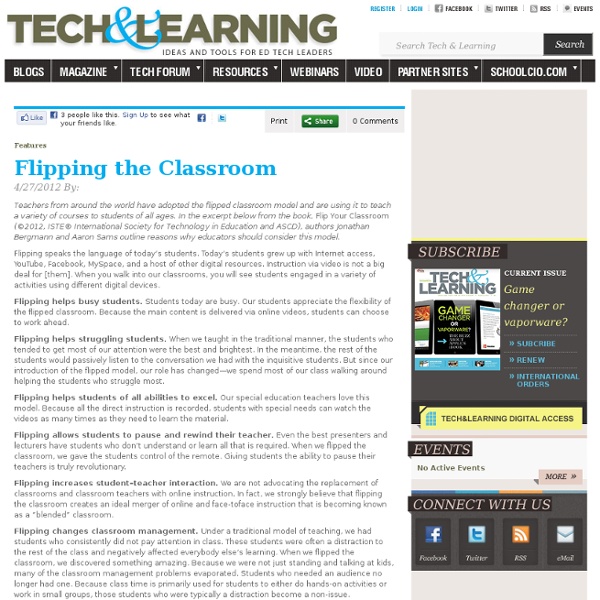To Flip Or Not Flip?
To flip or not to flip? That is not the essential question. In assessing the optimal classroom dynamics, I would argue that we need to take a good look at what our classrooms look like right now, what activities our students gain the most from, what we wished we had more time for, and what things about our class we wish we could eliminate. Do I flip: yes. Would I recommend it: enthusiastically.
Flipped Classroom - Savage Science
Who Said Lecture is Dead? Flipping the Traditional Classroom Model By Craig Savage I’ll let you in on a little secret: Teachers love to lecture. Okay, that’s probably not such a big secret. Just listen to one of my students: “Savage loves to hear himself talk.
How A Flipped Classroom Actually Works [Interview]
What happens when the students have more control in the classroom? Flipped classrooms are being tested out around the world and we’ve featured a few examples in case you wanted to see who is flippin’ out. Until now, we didn’t have an in-depth look at the effects of a flipped classroom or answers to the big questions it raises.
8 Observations on flipping the classroom
One of the more unfortunate buzzwords to appear in online education circles and the press is “flipping the classroom”. This means that instead of lecturing students in lessons in school, the teacher records the lecture as a video and uploads it to YouTube – or recommends other people’s videos to the students. The students watch the videos for homework, freeing up the lesson for interactivity, project work and so on. Would you REALLY want to watch this every night?!I not impressed with this brilliant “new” idea. Why not?
Flip Your Classroom - Get Your Students to Do the Work
Recently I shared lunch with colleague and friend, Mike Gwaltney. He teaches in a variety of blending settings both in class and online. We got into an interesting discussion about ways to deliver instructional content and learning process both in and outside the classroom. The conversation quickly turned to the notion of "flipping the classroom." This is the idea that teachers shoot videos of their lessons, then make them available online for students to view at home.
What Is The Role Of Content In Flipped Classrooms?
In a flipped classroom, students ‘attend’ the lesson outside of the classroom, typically in the form of teacher presentation videos or animated slide shows that can be viewed online, and in more sophisticated instances, followed by some diagnostic tests to indicate the progress of each student in the understanding of the material presented in that lesson. The intent is for students to know enough of the topic (to be taught in class) and, having reflected adequately on the ideas they encountered at home, return to class with questions to clarify their understanding. The benefits of a flipped classroom are progressively recognized and relatively well-documented (Fulton, 2012; Bergmann & Sams, 2013; Bergmann 2011; Ash, 2012). In its ideal state, a flipped classroom can transform the learning experience of students. Why Flip? Getting students to spend more time studying or learning can be a tall order, especially when faced with a topic that they do not see much need for knowing.
Why I Gave Up Flipped Instruction
A little over a year ago I wrote a post about the flipped classroom, why I loved it, and how I used it. I have to admit, the flip wasn’t the same economic and political entity then that it is now. And in some ways, I think that matters. Here’s the thing. When I recently re-read the post, I didn’t disagree with anything I’d said.
Creating learning objectives, flipped classroom style - Casting Out Nines
In my last post about the inverted/flipped calculus class, I stressed the importance of Guided Practice as a way of structuring students’ pre-class activities and as a means of teaching self-regulated learning behaviors. I mentioned there was one important difference between the way I described Guided Practice and the way I’ve described it before, and it focuses on the learning objectives. A clear set of learning objectives is at the heart of any successful learning experience, and it’s an essential ingredient for self-regulated learning since self-regulating learners have a clear set of criteria against which to judge their learning progress. And yet, many instructors – myself included in the early years of my career – never map out learning objectives either for themselves or for their students. Or, they do, and they’re so mushy that they can’t be measured – like any so-called objective beginning with the words “understand” or “appreciate”.



